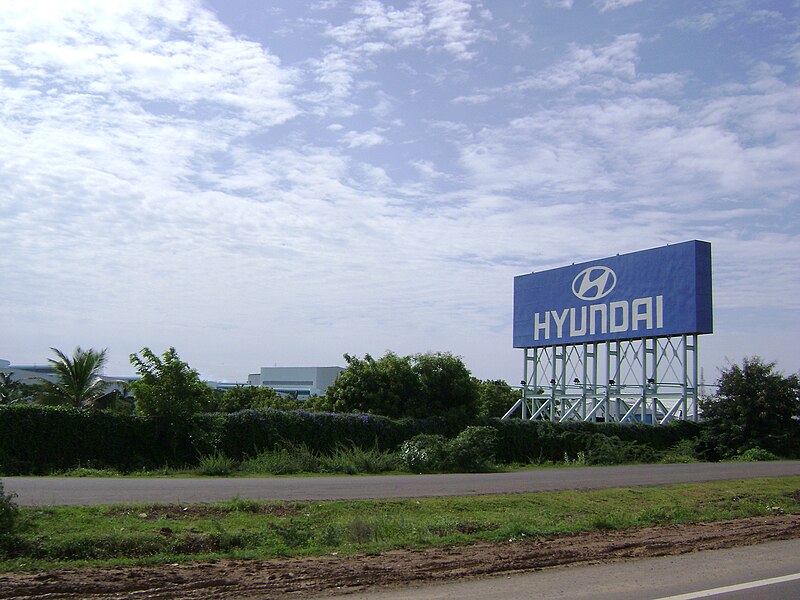
Hyundai Motor Company (Hangul : 현대 자동차 주식회사) (Hancha : 現代自動車株式會社) (Korean: 현대, Hyŏndae, IPA: [hjə́ːndɛ], modernity; KRX: 005380) is a Korean multinational automaker based in Seoul, South Korea which, along with Kia, comprises the Hyundai Kia Automotive Group, the world's fourth largest automaker as of 2009.As of 2011, it is the world's fastest growing automaker for two years running. In 2008, Hyundai (without Kia) ranked as the eighth largest automaker.

Headquartered in Seoul, South Korea, Hyundai operates the world's largest integrated automobile manufacturing facility in Ulsan, which is capable of producing 1.6 million units annually. The company employs about 75,000 persons around the world. Hyundai vehicles are sold in 193 countries through some 6,000 dealerships and showrooms worldwide. In 2010, Hyundai sold over 3.6 million vehicles worldwide

History
Chung Ju-Yung founded the Hyundai Engineering and Construction Company in 1947. Hyundai Motor Company was later established in 1967. The company's first model, the Cortina, was released in cooperation with Ford Motor Company in 1968. When Hyundai wanted to develop their own car, they hired George Turnbull, the former Managing Director of Austin Morris at British Leyland. He in turn hired five other top British car engineers.They were Kenneth Barnett body design, engineers John Simpson and Edward Chapman, John Crosthwaite ex-BRM as chassis engineer and Peter Slater as chief development engineer.In 1975, the Pony, the first Korean car, was released, with styling by Giorgio Giugiaro of ItalDesign and powertrain technology provided by Japan's Mitsubishi Motors. Exports began in the following year to Ecuador and soon thereafter to the Benelux countries. In 1991, the company succeeded in developing its first proprietary gasoline engine, the four-cylinder Alpha, and transmission, thus paving the way for technological independence.

In 1986, Hyundai exported the Pony to Canada, but not to the United States, because the Pony didn't pass emissions standards there. Canadian sales greatly exceeded expectations, and it was at one point the top-selling car on the Canadian market. The Pony afforded a much higher degree of quality and refinement in the lowest price auto segment than the Eastern-bloc imports of the period then available.
In 1986, Hyundai began to sell cars in the United States, and the Excel was nominated as "Best Product #10" by Fortune magazine, largely because of its affordability. The company began to produce models with its own technology in 1988, beginning with the midsize Sonata.
In 1996, Hyundai Motor India Limited was established with a production plant in Irungattukottai near Chennai, India.
In 1998, Hyundai began to overhaul its image in an attempt to establish itself as a world-class brand. Chung Ju Yung transferred leadership of Hyundai Motor to his son, Chung Mong Koo, in 1999. Hyundai's parent company, Hyundai Motor Group, invested heavily in the quality, design, manufacturing, and long-term research of its vehicles. It added a 10-year or 100,000-mile (160,000 km) warranty to cars sold in the United States and launched an aggressive marketing campaign.

In 2004, Hyundai was ranked second in "initial quality" in a survey/study by J.D. Power and Associates. Hyundai is now one of the top 100 most valuable brands worldwide. Since 2002, Hyundai has also been one of the worldwide official sponsors of the FIFA World Cup.
In 2006, the South Korean government initiated an investigation of Chung Mong Koo's practices as head of Hyundai, suspecting him of corruption. On April 28, 2006, Chung was arrested, and charged for embezzlement of 100 billion South Korean won (US$106 million).[14] As a result, Hyundai Vice Chairman and CEO, Kim Dong-jin, replaced him as head of the company.
On September 30, 2011, Yang Seung Suk announced his retirement as CEO of Hyundai Motor Co. In the interim replacement period, Chung Mong-koo and Kim Eok-jo will divide the duties of the CEO position.
Business
In 1998, after a shake-up in the Korean auto industry caused by overambitious expansion and the Asian financial crisis, Hyundai acquired rival Kia Motors. In 2000, the company established a strategic alliance with DaimlerChrysler and severed its partnership with the Hyundai Group. In 2001, the Daimler-Hyundai Truck Corporation was formed. In 2004, however, DaimlerChrysler divested its interest in the company by selling its 10.5% stake for $900 million.

Hyundai has invested in manufacturing plants in the North America, India, Czech Republic, Pakistan, China and Turkey as well as research and development centers in Europe, Asia, North America, and the Pacific Rim. In 2004, Hyundai Motor Company had $57.2 billion in sales in South Korea making it the country's second largest corporation, or chaebol. Worldwide sales in 2005 reached 2,533,695 units, an 11 percent increase over the previous year. Hyundai has set as its 2006 target worldwide sales of 2.7 million units (excluding exports of CKD kits). In 2007 it reached 3,961,629 worldwide vehicle sales—surpassing Fiat, Chrysler, PSA/Peugeot, Nissan, and Honda.

Hyundai motor vehicles are sold in 193 countries through some 5,000 dealerships and showrooms. After a recent survey of global automotive sales, Hyundai is now the fourth largest automaker in the world as of 2009.
Hyundai Motor Company's brand power continues to rise as it was ranked 65th in the 2007 Best Global Brands by Interbrand and BusinessWeek survey, with brand value estimated at $5.0 billion. Public perception of the Hyundai brand has been transformed as a result of dramatic improvements in the quality of Hyundai vehicles.



